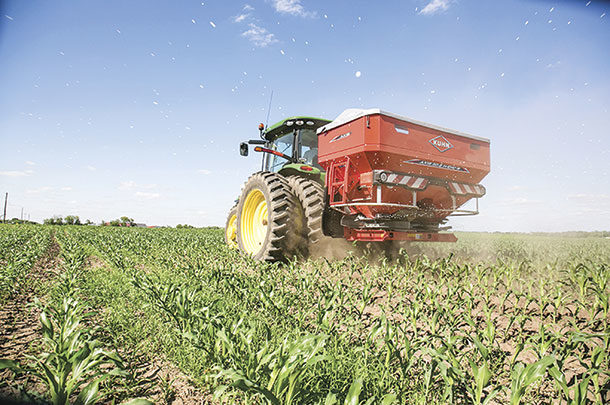Before or after crop harvest, or between alfalfa cuttings, it is critical to ensure the crop has the appropriate nutrients replenished for maximum yield. Often this is accomplished using granular fertilizers, such as potash, urea and a variety of other elements and nutrients the plant needs (which ultimately end up as part of the animals’ diet and nutrition plan). Many times, different types of dry fertilizer are applied, whether together as a blend or individually from a multiple-product spreader. The main trade-off to keep in mind is precision versus productivity.
4R principles
First, no matter which dry nutrients you choose for your farm or how you apply them, it is very important to keep the 4Rs of nutrient stewardship in mind. What are the 4Rs? As the name implies, they are four factors you want to think about: right source, right rate, right time and right place. You can practice the 4Rs in your operation whether you choose single-product or multiple-product fertilizer placement.
Single-product application
Spreading dry fertilizers individually has tremendous benefits in terms of spread pattern width and precision. When applying products individually, you can ensure the spreader is set exactly to the product’s individual ballistics, rather than a compromise between multiple settings. This provides the widest spread patterns for each material, since the spreader settings are “focused” on that one product. Therefore, the spreader can be optimized for that product and can create wider patterns. Some single-product spreaders on the market can actually save time versus multiple-product applications due to the wider patterns and higher working speeds.
Another benefit to single-product application is the accuracy of the pattern. Just as with working widths, you can optimize the spreader for a single product to create the most accurate pattern without worrying how those settings affect other products. Especially when using a broadcast spreader, patterns will be more precise when applying a single product.
What are some downsides to applying a single product with each pass? It mainly comes down to real and perceived logistics. Applying a single product increases trips required across the field – in turn, increasing soil compaction. Applying single-product passes may require additional investments in machines and labor. You must also make sure the tender is set up properly with a single product.
Multiple-product application
Another fertilizer option to apply dry nutrients is applying multiple products per pass, either through blending or using separate hoppers and metering each to the spreader discs at the same time.
One of the largest perceived advantages to a multiple-product spreading system is the ability to cover lots of acres quickly. When fertilizers are combined in a blend or multiple-product spreader, you will be able to get two (or more) products onto the field in a single pass. If your nutrient requirements are relatively homogenous across your fields, blending products may work best for you, especially if you have a single-bin spreader.
If you sample the soil or crop and discover you have varying requirements for nutrients in your fields, a multiple-bin spreader may be a better answer than blending. With a multiple-bin spreader, each fertilizer is contained in its own hopper and is metered according to your location in the field. When the appropriate location is reached, product is released, combined and spread.
Rate control is rarely as big of an issue with multiple-product spreaders as the spread pattern itself. The operational efficiency gains of spreading multiple fertilizers in a single pass are often blunted by the inaccuracy of the spread pattern. Most machines on the market can accurately meter two or more products at the correct rates, especially when they are kept in separate bins or hoppers. However, do these products actually reach the correct spots in the field and have the desired effect on the crop?
Research conducted in 2017 by Ohio State University shows an appreciable difference in spread pattern for the products tested. Both diammonium phosphate (DAP) and potash were tested, which are common dry nutrients throughout North America. When applied together but metered independently, only five pans of the 55 collected had the proper ratio of DAP and potash, leading to concerns with the quality of the spread pattern.
Most operators think by narrowing the spread pattern to match the properties of the “worst” product ballistically, these challenges can be overcome. However, most of the time the efficiency gain is canceled out, since a broadcast spreader with a single set of discs will force all products to fly at these settings. Even for the “better” ballistic products, settings that are not optimized for that product are being used, which affects overall performance and field efficiency. An air boom spreader resolves some of the spread-pattern issues when spreading multiple products, but the products must still be metered accurately. Air-boom spreaders tend to bring a high initial cost and greater maintenance requirements than simple spinner spreaders.
Conclusion
Many producers apply granular fertilizers in both single-product and multiple-product passes. Both have their advantages and disadvantages. If you are interested in the most precise application for each product, choose single-product applications to take advantage of the ballistic properties of your nutrients. If you need to cover a lot of acres and are less concerned with the exact quality of the spread pattern, a multiple-product application or blending may be for you. Different machines on the market will be best suited to each type of spreading, so be sure to choose the machine that best fits your operation and practices.
References omitted but are available upon request. Click here to email an editor.
Phil Loduha is a product specialist with Kuhn North America.












